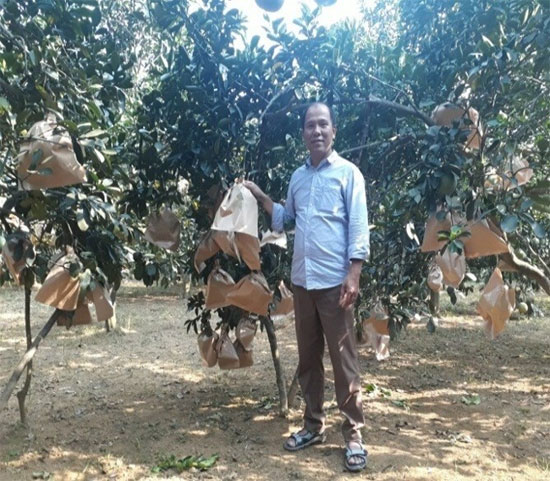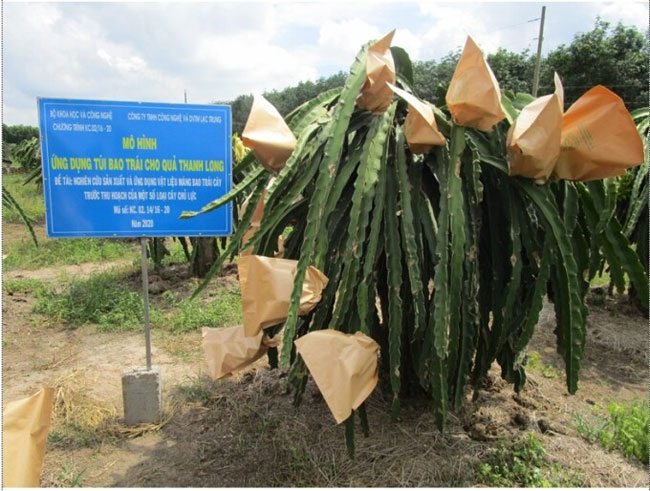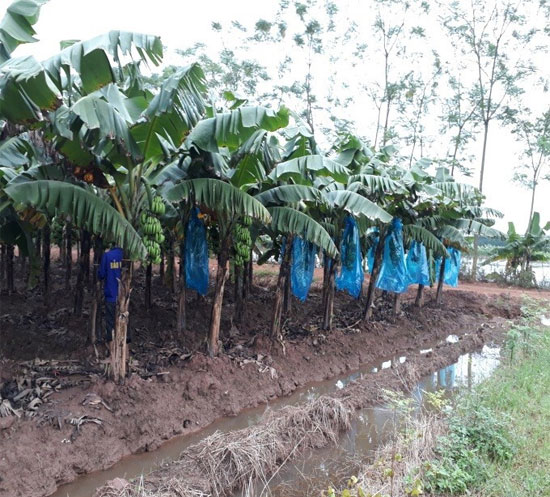Vietnamese scientists have successfully developed a protective film for fruits against pests, diseases, and pesticides, which is also biodegradable.
The idea of creating a pre-harvest fruit wrapping film was initiated by Dr. Hoang Tuan Hung, Director of the Institute for Research and Development of New Materials at Lạc Trung Technology and Trade Company, over 10 years ago. The goal was to prevent attacks from insects such as fruit borers, stink bugs, and flies, limit the spread of fungal diseases, enhance the fruit’s appearance, and increase its value.
According to Dr. Hung, the wrapping film is made from PE film material, non-woven PP fabric, and composite paper. Depending on the type of fruit, the film’s composition is calculated to suit its biological characteristics and size. Five key fruit groups were selected for testing: grapefruit, oranges, mangoes, bananas, and dragon fruit.

Fruit wrapping bag for oranges. (Photo: Research team)
Unlike common fruit wrapping films available on the market, such as nylon bags and non-woven fabric bags, the film developed by the team contains biodegradable additives. “We have successfully created protective wrapping materials for fruits that are also biodegradable, which is a significant achievement,” Dr. Hung stated. The estimated biodegradation time for the various types of bags is 13 months (for composite paper bags), 20 months (for non-woven PP fabric), and 24 months for PE film bags.
Dr. Hung explained that each type of fruit has different ecological characteristics, hence the timing for wrapping and unwrapping will vary. For instance, green grapefruit should start wrapping when the fruit has a diameter of 4-6 cm, for a duration of 6.5 months. The wrapping film is removed 15 days before harvest.
For Diễn grapefruit, wrapping typically begins when the fruit is 4 weeks old, lasting for 7 months, with the film removed 20 days before harvest. Cao Phong oranges are wrapped when the flowers bloom, lasting for 100 days, and removed 10 days before harvest. In contrast, pink-fleshed dragon fruit is wrapped a week after the flowers bloom, for one month, with the wrapping removed at the time of harvest.
Dr. Hung also noted that during the wrapping process, random checks are conducted weekly on some fruits to guard against pest and disease attacks.
The wrapping film is applied to various fruits: bananas (Phú Thọ), mangoes (Sơn La), oranges (Cao Phong), Diễn grapefruit (Chương Mỹ), and dragon fruit (Bình Thuận). Results indicate that the wrapped areas yield beautiful fruits that are free from pests, fungi, and insect attacks, reducing sunburn and spoilage.
According to the research team, due to the material’s properties, water droplets have difficulty permeating through the tiny holes in the wrapping film, so orchards that require pesticide spraying will not have the chemicals absorbed by the fruits. “This technique also helps improve the color of the skin, making the fruit look better, ensuring safety, and providing higher economic value, increasing by 18-40%,” Dr. Hung added.

Fruit wrapping enhances the yield of Bình Thuận dragon fruit. (Photo: Research team).
The company has currently established a production line for composite paper fruit wrapping bags with a capacity of 100 tons per year. The selling price of the products ranges from 650 to 3,500 VND each, depending on the type.
According to Dr. Hung, this wrapping film can be reused, helping farmers save costs in producing clean, high-quality fruits. He mentioned that the team is continuing to refine the technology to optimize costs, enhance product quality, and research additional fruit types such as lychee, custard apple, guava, and longan.

Wrapping film for bananas. (Photo: Research team).
Mr. Nguyen Van Lam, Deputy Director of the Institute for Research and Development of Regions (Ministry of Science and Technology), assessed that the research on biodegradable wrapping materials for fruits is highly scientific and practical. The results of this research can lead to the creation of various biodegradable films suitable for wrapping different types of fruits with varying weights, sizes, and biological characteristics.
“The research results provide a scientific basis for producing various types of rapidly biodegradable films, contributing to ecological environmental protection and promoting the development of safe and high-quality agricultural products,” he stated. This is one of the projects under the application research and development program for new materials (KC.02 phase 2016-2020), part of the national key science and technology program led by the Ministry of Science and Technology.

















































